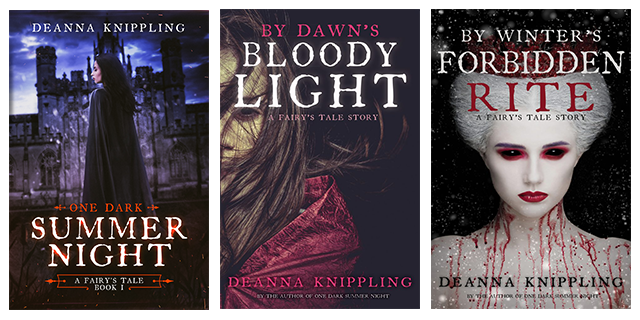One Dark Summer Night: The Stories behind the Story
The overarching story from One Dark Summer Night is a fairly typical one for the fae: the fae have been interfering with the mortals again, and have left behind them a changeling—or possibly more than one. The main twist in the tale comes when several human scientists at an isolated university in the Midwest decide to not just try to banish the changelings, but experiment upon them.
In building the world of the novel (which I’m working into a series), I pulled together several different sources of stories. I didn’t really consider what I was doing at the time; I was under deadline and was trying to pull everything together as quickly as possible. But sometimes the muse provides gifts that we only realize later.
What I found, when I went to look back at what I had written, was that my sources split into two groups: traditional tales and some “urban legends” from when I was going to college, rumors that were so unsubstantiated that I can’t even remember if I’m getting them straight.
On the more traditional side, my inspirations are the stories about the fae and changelings, and (to a much lesser extent) about vampires.
The legend of changelings, or mortal babies swapped for ones from the fae, seems to be common across several different cultures, but the ones I know best are from the stories of W.B. Yeats’s Folk and Fairy Tales of the Irish Peasantry (1888), which I probably know at about exactly the right level for a writer—well enough to inspire, but not well enough to be obsessively accurate about.
From Yeats’s section on Changelings:
“Sometimes the fairies fancy mortals, and carry them away into their own country, leaving instead some sickly fairy child, or a log of wood so bewitched that it seems to be a mortal pining away, and dying, and being buried. Most commonly they steal children. If you “over look a child,” that is look on it with envy, the fairies have it in their power.”
And, toward the end of that section:
“Those who are carried away are happy, according to some accounts, having plenty of good living and music and mirth. Others say, however, that they are continually longing for their earthly friends. Lady Wilde gives a gloomy tradition that there are two kinds of fairies—one kind merry and gentle, the other evil, and sacrificing every year a life to Satan, for which purpose they steal mortals.”
The idea has caught at me ever since I read that: the fae have someone else they owe a debt to, which causes them to act against mortals.
In addition, it seems that many of the fairy mounds of Ireland were originally burial mounds from pre-Christian to early-Christian Irish pagans (depending on the site, they may instead have been temporary fortifications). The mounds were held as sacred, being under the protection of the Aos Sí who lived there. That is, the same fae who would sometimes snatch up a child or adult, and replace them with someone who wasted and died. Or would abduct someone entirely, returning them to their homes a hundred years later, seemingly untouched by time.
The more I thought about it, the more it sounded like the fae in Ireland served the same purpose as vampires did in Eastern European mythology: to mediate a half-world between the living and the dead.
My fae aren’t vampires; they don’t suck blood. But the idea that the fae weren’t exactly cute little fluttery things from a Disney movie was definitely set in my head, and my fae are perfectly willing to commit violence upon anyone who crosses them—and to replace them with changelings.
On the less traditional side of my inspirations for the story, that is, the “urban legend” side, the inspirations are much harder to track down—in fact, so hard to track down that I’m not going to explicitly name my alma mater, because of the complete lack of accuracy.
Some of the stories (whether accurate, genuine legends, “urban legends,” or wisps of rumor) that I remember include:
- There were tunnels that ran underneath the entire campus, but that no one used anymore because they were either unsafe or haunted.
- Grad students in biology had to secretly vivisect dogs in order to pass their classes, as a sort of rite of passage.
- The Spirit Mound, a Native American site outside my alma mater, was haunted by ghosts, dangerous spirits, or the “little people,” who once wiped out a band of over 350 warriors in a single night.
- An old highway bridge in the town had been half-destroyed, and the half that still remained was haunted (it was definitely creepy and covered with layers and layers of graffiti).
- There were Wendigo (dark, cannibalistic spirits from Native tribes nowhere near where I went to college) in the woods near the river.
- Several gay people had been murdered by frat boys out in those same woods by hanging, and their ghosts would appear on tree branches (as far as I can find out, this one definitely wasn’t true).
Some other elements that got thrown in include sculptures and Shakespeare.
While I was at the school, there were a number of art students who had a propensity for welding all sorts of strange things together, adding found objects, and leaving their sculptures in town—I think they were just leaving the sculptures at their rental houses, but at the time it seemed Strange and Mysterious, and it stuck in my head.
And the theater department was (and is, if I understand correctly) top-notch, and had a specialty of pulling off excellent Shakespeare. The lead Shakespearean when I went was a professor named Dr. Ron Moyer, who unfortunately passed in 2018. While I was there, he passed on a small sliver of his love for the bard to me—especially regarding Midsummer’s.
Because I was in such a hurry, the other elements in the story are pretty much as given: the train-car diner, the winding trail down to the other side of town, the train tracks, the various trailer courts, and the all-night grocery store.
I’ve returned to the college since I graduated several times, and it’s no longer the same town that I remember; it’s no longer magical, and no longer creepy or dangerous. (And the diner, which passed through several iterations, is gone.) A lot of the things that were broken back then have been removed or replaced. It’s a cleaner, shinier, more well-maintained place. People have died, disappeared, moved on: it feels like a different town now. Not quite a changeling of what it once was, but definitely a replacement.
I hadn’t realized, as I was hurriedly writing a story about what was “really” going on underneath the surface of the town, that I was really writing about my nostalgia for those days: the crazy adventures that I had with friends, the lonely, cold nights of walking out in the woods by the river (and thinking: I hope the frat boys don’t get me), the sense that things were decaying more than anyone wanted to admit.
I was also writing about how the headiness of those days had faded. The people I had known were gone, dead, or changed. The town itself had moved on, and only some weird half-twisted memories in my head remained.
I wrote this story because I wanted to capture the feel of the town—and then the feel of everything being wrecked and changed afterward, to write about what it felt like to suddenly find out that it was all gone. In the story, everything is destroyed in a matter of hours rather than decades, but the gradual passage of time does tend to come as a shock, the first time you catch it happening.
Everyone has a first love, I suppose; underneath the words that I wrote is the story of my first real love of a place, and the way it became something I didn’t recognize, and never was the way I thought it was in the first place.
But these things happen. That’s one of the reasons the fae are still around. How would we be able to describe the world without them?

About DeAnna
DeAnna Knippling is always tempted to lie on her bios. Her favorite musician is Tom Waits, and her favorite author is Lewis Carroll. Her favorite monster is zombies. Her life goal is to remake her house in the image of the House on the Rock, or at least Ripley’s Believe It Or Not. You should buy her books. She promises that she’ll use the money wisely on bookshelves and secret doors. She lives in Colorado and is the author of the A Fairy’s Tale horror series which starts with By Dawn’s Bloody Light, and other books like The Clockwork Alice, A Murder of Crows: Seventeen Tales of Monsters & the Macabre, and more.
Find DeAnna
Website ~ Facebook ~ Pinterest ~ BookBub ~ Amazon ~ Twitter ~ Goodreads

One Dark Summer Night is available for a limited time in The Realm of Faerie bundle. Bundle buyers have a chance to donate a portion of the purchase price to the charities Mighty Writers and Girls Write Now.
Enter the Realm of Faerie, a world of beauty, danger, and enchantment. But remember the legends if you want to make it back home again…


